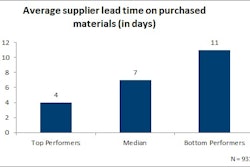
Read any news about China’s economy and supply chain challenges are usually mentioned: The pressures of a rapidly changing economy, government regulations and shifting customer demands are creating an uncertain environment for any company—domestic or foreign—doing business in China.
While many economists and analysts warned of a Chinese economic slowdown in recent months, there is still plenty of opportunity to engage with and serve this growing market. For instance, some of the largest retailers in the region are looking beyond what’s happening at home and toward the greater global market—especially North America and Europe. These other markets present a huge opportunity for Chinese companies to reach new consumers, and executives are anxiously exploring the fastest and most profitable routes to reach them.
Focus on the Supply Chain
Growth at home and the desire to expand abroad are leading many companies to reexamine their supply chain and logistics operations. As a result, market conditions are providing new opportunities for technology and service providers, though any company looking to serve the Chinese market should be aware of key trends and challenges that come with these exciting times.
The Importance of a Demonstrable Return on Investment (ROI)
Proving an ROI is important to most companies wherever they are on the globe, but it’s particularly needed in China. Currency fluctuation continues to foster market uncertainty. In a place where companies have access to bountiful and inexpensive labor, organizations are often more apt to use people to solve logistics problems. It’s a short-term solution to be sure, but an inexpensive one.
Therefore, foreign companies wanting to provide supply chain or logistics services in China—especially technology or automation solutions—need to prove a fast ROI. And of course, the tendency to use people over automated solutions is a common occurrence, but not a blanket statement. Later on in this piece, I’ll discuss how the largest third-party logistics (3PL) provider thrived during China’s biggest e-commerce holiday thanks to implementing a forward-looking, long-term warehouse solution.
While the bottom line is important, serving the China market also requires quality assurance. There is a growing effort to counter the stereotype that China is a manufacturer of low-quality goods, and so companies that have serious strategies for global expansion also know that they have to provide quality products if they hope to have sustained success abroad.
Flexibility Is a Requirement
China is a fast-changing market, with consumer demands constantly shifting. Government regulations are increasing, aiming in part to clean up unsavory business practices. There are going to be unknown hurdles for those companies expanding outside of the country. All of this creates the need for a flexible supply chain that can adapt and be nimble when faced with new opportunities.
With so much changing inside and outside of the country, technology providers need to provide flexible solutions that can serve customers long term. This relates to the emphasis on ROI noted above, and so, any provider than can demonstrate flexibility is better positioned to prove a fast ROI.
Expect an Education
More than one of my colleagues in China remark that the Chinese supply chain appears to be two or three generations behind the North American one. For example, most companies in the U.S. have no desire to build a custom warehouse management system (WMS) or enterprise resource planning (ERP) system. Instead, they seek out a vendor to provide a solution that meets most of their needs, with some customization or configuration involved as needed. In China, building a solution from scratch is a consideration, especially if it’s the least-cost option.
Anticipate the need and time for educating potential partners and customers about your solutions’ benefits. Some vendors also provide professional services, such as logistics planning or strategies for improving supply chain operations. And don’t be surprised if there is a request to bundle software and services under some type of a fixed-fee scenario.
The Singles Day Challenge
Let’s take a look at one example of how a 3PL provider in China took the long view when it came to supply chain investments—and how that helped it navigate one of the biggest e-commerce events on the planet.
CNSS is a Chinese 3PL service provider focused on e-commerce customers in retail, food and beverage, automotive and health care. Its goal is to become the world’s largest logistics services provider by giving each customer the speed, flexibility and adaptability to respond to changing business needs. So when it built its newest warehouse, which is approximately 530,000 square feet (50,000 square meters), outside of Shanghai, it knew it needed a warehouse management system (WMS) that could handle its initial 800,000 stock-keeping units (SKUs) across five levels.
CNSS selected a Tier 1 best-of-business WMS that would help its supply chain keep up with its projected double-digit growth. The WMS is configurable to any specific business process or workflow. The CNSS team can make process modifications directly, without having to go through the vendor. Flexibility and independence were critical for supporting the growth of CNSS throughout Asia.
The biggest test for CNSS was the November 11 holiday. Known as 11.11 or Singles Day, it’s an annual e-commerce shopping event in China during which online retailers slash prices, and China’s bachelors and bachelorettes treat themselves to discounted goods. It’s hard to overstate the enormity of this event. Alibaba, the huge Chinese e-commerce company, said it took in $1 billion in less than 20 minutes last year. In total, Alibaba reported that its sales reached a record $9.3 billion on Singles Day. For comparison, only about $3 billion worth of goods is sold in the U.S. on Black Friday and Cyber Monday, according to the Boston Consulting Group.
On 11.11, CNSS successfully processed approximately 300,000 orders in a single day at one distribution center. With sophisticated warehouse technology, a long-term view of profitability and a high level of automation, the company served its customers in the ultimate test of e-commerce efficiency and accuracy.
Transformation and Opportunity
So many factors are making for an exciting time in China, and are creating significant opportunities for supply chain growth and transformation. Knowing and preparing for some of the common challenges and trends in the region can help better prepare you for seeking out opportunities and serving customers successfully.
















